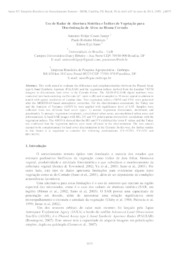Uso de Radar de Abertura Sintética e Índices de Vegetação para Discriminação de Alvos no Bioma Cerrado.
Uso de Radar de Abertura Sintética e Índices de Vegetação para Discriminação de Alvos no Bioma Cerrado.
Author(s): COUTO JUNIOR, A. F.; MENESES, P. R.; SANO, E. E.
Summary: ABSTRACT -This work aimed to evaluate the differences and complementarities between the Phased Array Type L-band Synthetic Aperture (PALSAR) and the vegetation indices derived from the Landsat 7-ETM imagery to discriminate land cover in the Cerrado biome. The ALOS-PALSAR digital numbers were converted into backscattering coefficients ( o°; units = dB) and resampled to 30 meter spatial resolution to match with spatial resolution of Landsat data. Two vegetation indices (NDVI and EVI) were generated after the MODTRAN-based atmospheric correction. For the discrimination assessment, the Tukey test and the Analysis of Variance (ANOVA) were applied with significance level of 0.05. Samples were collected from two different land cover types: 1) natural vegetation (forestlands, shrublands and grasslands); 2) antropic vegetation (croplands, consolidated urban areas, unconsolidated urban areas and reforestations). L-band SAR images with HH, HV and VV polarizations showed low correlations with the vegetation indices. The ANOVA showed that the HH and VV exhibited the lower F values and the Tukey test evidenced that the vegetation indices were more efficient in the discrimination. The two sensors seemed to be complementary for land cover discrimination in the Cerrado. In this way, for further studies in this biome it is important to consider the following combinations: HV+NDVI, VV+EVI and HH+NDVI
Publication year: 2011
Types of publication: Paper in annals and proceedings
Unit: Embrapa Cerrados
Observation
Some of Embrapa's publications are published as ePub files. To read them, use or download one of the following free software options to your computer or mobile device. Android: Google Play Books; IOS: iBooks; Windows and Linux: Calibre.
Access other publications
Access the Agricultural Research Database (BDPA) to consult Embrapa's full library collection and records.
Visit Embrapa Bookstore to purchase books and other publications sold by Embrapa.

